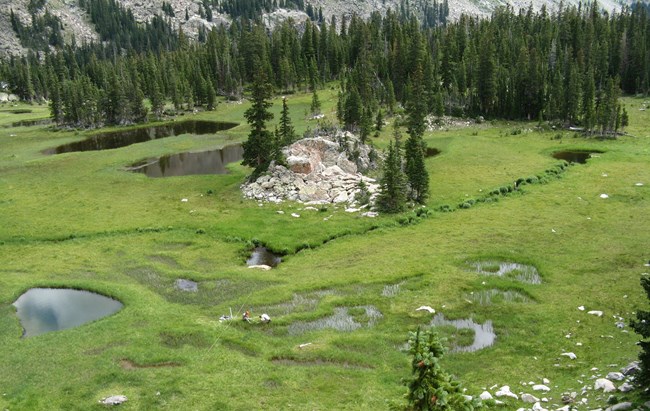
Importance/IssuesWetlands are important components of nearly all Rocky Mountain Network watersheds and provide many valuable ecological and socioeconomic functions. For example, relative to their area, wetlands support a disproportionate amount of the biodiversity in each Rocky Mountain Network park. Wetland vegetation is also an excellent indicator of changes in groundwater levels and sediment dynamics. However, wetlands are vulnerable to stressors functioning at the site and landscape scales, and many Rocky Mountain Network wetlands are likely in a degraded condition (e.g., species assemblages and dynamics may not be within a normal range of variability due to hydrologic modifications such as changes in groundwater levels or stream diversions, fill, overgrazing by native ungulates, historical grazing by domestic livestock, atmospheric deposition, and invasion by exotic taxa). Preliminary Monitoring Objectives
Potential Measures
Protocol StatusThe Rocky Mountain Network Wetlands protocol has been peer-reviewed and published in 2015 (Narrative and SOP). We developed the protocol in collaboration with Dr. David Cooper and others at Colorado State University. We monitor wetlands annually using this protocol in Florissant Fossil Beds National Monument, Glacier National Park, Great Sand Dunes National Park and Preserve, and Rocky Mountain National Park. To meet specific information needs at Glacier National Park, we adapted the protocol to more effectively capture hydrologic changes in the park’s alpine wetlands. Parks This Protocol is Monitored At
Vital Signs This Protocol Monitors
Publications & ReportsSource: NPS DataStore Saved Search 3498. To search for additional information, visit the NPS DataStore. Source: NPS DataStore Saved Search 1950. To search for additional information, visit the NPS DataStore. Source: NPS DataStore Saved Search 2629. To search for additional information, visit the NPS DataStore. |
Last updated: September 19, 2025
